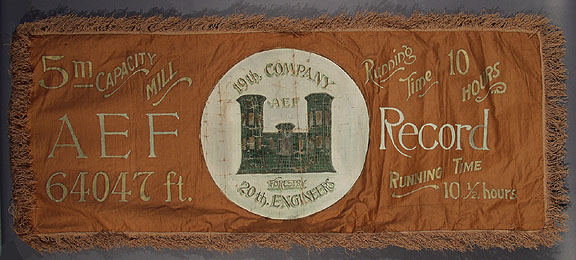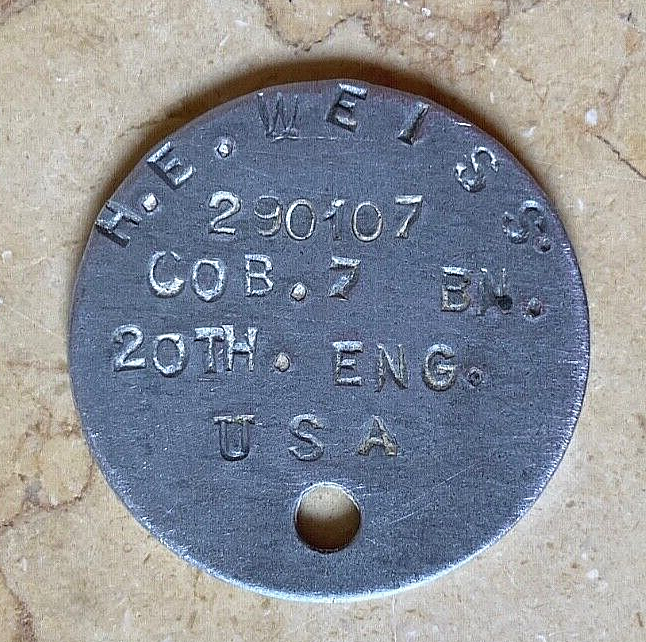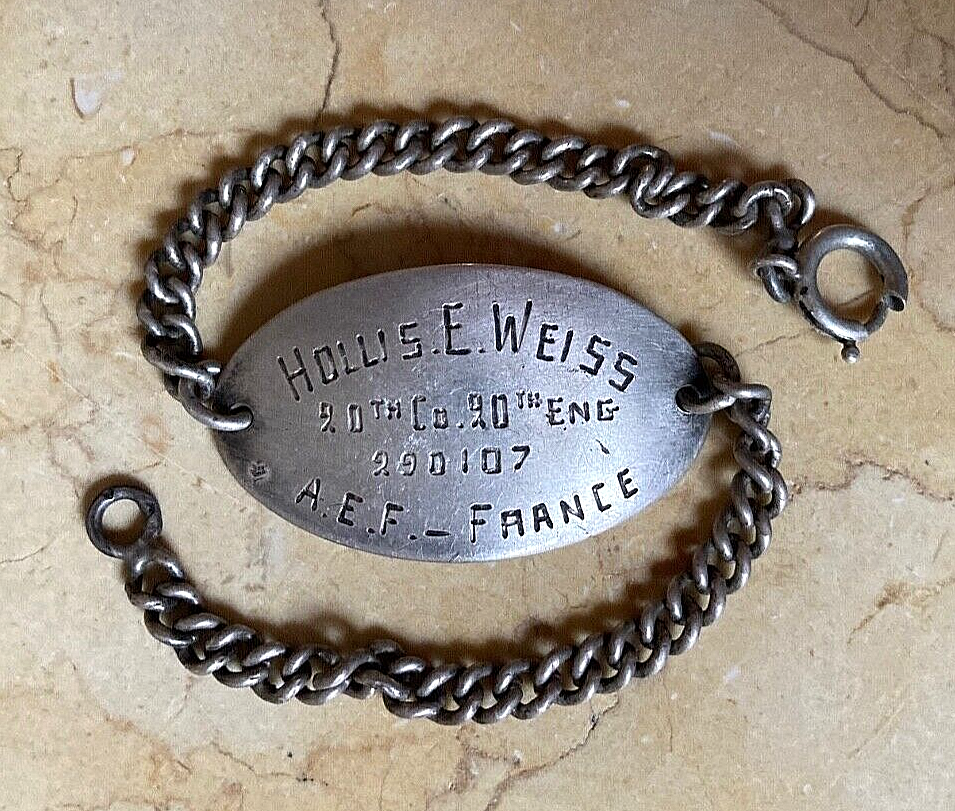


7th Battalion, 20th Engineers
The Seventh Battalion
Note: Most of the text of this article comes from "TWENTIETH ENGINEERS -- FRANCE -- 1917-1918-1919"

The 7th Bn., 20th Engineers, was organized at Camp American University, D. C., January 15, 1918, consisting companies (A, B and C) of 250 men each; Headquarters Detachment of 24 men; and Medical Detachment of 16 men. The personnel came from all sections of the country, the battalion having men from 47 states as well as Alaska and Hawaii territories. The states of California, Pennsylvania, and Montana were in the majority in about equal numbers; there was also a heavy representation from the other northwest states, from the Carolinas and Tennessee, and from the southwest. As soon as A and B Companies were organized they were sent to Belvoir on the Potomac, now Camp Humphries, Va., where they suffered discomforts equal to anything they later endured in France. In the meantime C Company was filled up. About February 1st, Maj. C. E. Clark of Wilmington, N. C., was placed in command; A and B Companies moved back from Belvoir, and the time was spent in drill and preparation for overseas service.

Pre-Deployment Photo of the 7th Battalion, 20th Engineers at Camp American University, Washington, D.C.
Photo courtesy of Lori Myers, whose great-grandfather was Private First Class William Arthur Twing,
born 8 May 1892 in Wisconsin, died 19 March 1943 in California
On the afternoon of February 15th the battalion marched through the streets of Georgetown, crossed Aqueduct Bridge just below Ft. Myer, and entrained at Rosslyn, Va. The unit at that time had 20 officers and 777 men. The following morning the outfit detrained at Jersey City, were transported by ferry to Hoboken, and marched on board the "Pastores," formerly a "banana boat" in the Central American trade, but destined to make more trips to France with troops than any other vessel. In addition to the 7th Battalion we took over two replacements for the 1st and 2nd Engineers.

USS Pastores
The transport dropped down the bay on the 16th, and on 17th began the voyage across the Atlantic in company with seven other transports convoyed by the cruiser ''Huntingdon" The crossing was made by the southern route and fine weather was enjoyed during the entire voyage, which was without incident with the exception of a submarine scare on March 1st. We were always of the opinion that we accounted for a U-Boat but this was never confirmed.
On the morning of March 4th, the convoy entered the port of St. Nazaire, the unit debarking and marching in the rain to Camp No. 1, where we soon formed an acquaintance with vin rouge and ''Woodbines." The former acquaintance ripened into a warm and lasting friendship. After a few days we received orders to the effect that the outfit was detailed for duty with the French Army, and on March 12th made the journey by rail to the stations we were to occupy for eleven long months. At Tours, B Company left us, going to Blois, Loire et Cher, where they made camp in the center of the Foret de Russy, a few miles south of the city. This was to be the scene of their labors until late in the summer, when they moved camp to the village of Mont, on the railway southeast of Blois.

Headquarters with A and C Companies proceeded to Chateauroux, Indre, where the two former units detrained, C Company going on to the village of Ardentes, 13 kilometers southeast. A Company marched to the tiny village of Le Poinconnet, 5 kilos south of Chateauroux on the northern edge of the Foret de Chateauroux. Company C established camp just west of Ardentes on the eastern edge of the same tract—a fine forest of oak and beech easily accessible by roads maintained by the French forest service.Headquarters Det. remained in Chateauroux, a city of some size; after being quartered a few days at the French Artillery Caserne, headquarters was established in a vacant wing of the Hotel Ste. Catherine, and was maintained there until about June 1st, when it was moved to the sawmill camp south of the railroad yards. At this time we were the only American troops in this vicinity with the exception of Base Hospital No. 9, on the eastern outskirts of the city.

Private James Economou
21st Company
Logging operations were started almost at once, and by the end of May the sawmills were in operation—that of Co. A at Chateauroux, Co. B at Mont, Loire et Cher, and Co. C at Ardentes. Each company had two 5M ft. bolter mills, and during most of the time up to the armistice these were run day and night. A keen rivalry developed between the shifts at each mill, and between the three companies, some extraordinary cuts were made. One company [the 19th Company, formerly Company A, 7th Battalion] hung up a record of 64,000 board feet of lumber and ties on a 5M mill with 48 inch circular saw, in 10 1/4 hours.

While the mills were kept going at full capacity, the output going to the French Army at the front , numerous other tasks were assigned to the battalion, from handling steel rails at Montier-Chaume after the 11th Engrs left for the front, to setting caterpillar tractors and tanks at Gievres, (and the Army never found a job at which the 20th Engineers did not make good.)



Silver metal matchbox belonging to Sergeant K. M. Anderson, 19th Company (Company A, 7th Battalion), 20th Engineeers
On August 1st, Maj. Clark was sent back to the United States and Capt. H.A. Maas of Company A was placed in command of the battalion, the work going on with un-interrupted vigour. After the armistice the night shifts were discontinued and the strain somewhat relieved. Early in January orders were received to be ready to sail about February 15th and the battalion was released from duty with the French Army February 1st.


ID tag and ID bracelet of Hollis E. Weiss, 20th Company (Company B, 7th Battalion), 20th Engineers
The powers that were, however, decreed that the outfit should remain in France to help rebuild and repair roads worn out by American Army transport,and after a few days of "grousing" the men fell to their new and unfamiliar task with the same energy and spirit which had distinguished their former efforts. A and C Companies remained at their stations; B Company was moved by truck from Mont to Vendome, Loire et Cher, on the main road from Tours to Paris, and Bn. Hq. was established in a chateau opposite the ancient church at Vendome February 12, 1919, just eleven months after their arrival at Chateauroux. Capt. Maas was appointed district officer in charge of engineer work in that vicinity. In addition to B Company a company of the 816th Pioneer Infantry was placed at his disposal.

William Edward Dunn and Friends
Company C, 7th Battalion, 20th Engineers
At this time the 6th Cavalry moved to the Caserne Rochambeau at Vendome, and we were given the task of remodeling this old French cavalry post for them. The old mangers and stalls were torn out and replaced, a complete water and electric lighting system was installed, kitchens, mess-halls, and bath-houses built, roads resurfaced, in short it was made a model post capable of quartering 2000 men and their mounts.
Late in April were were notified to be ready to move by May 1st, and on May 5th entrained for the first leg of the journey home. The battalion was reunited at Tours - the first time in fourteen months they had been together, and proceeded to Nantes. Detraining there the battalion marched to the billeting area of St. Sebastian on the outskirts of the city. Here ten pleasant days were spent—looeys and sergeants drilling their platoons, company clerks feverishly preparing reports and rosters, the rank and file making the most of the beautiful weather —playing baseball (it might be well to mention that B Company's team never suffered a defeat in France) and swimming in the river. It was here that little Gemes Economou was drowned on the eve of going home after fifteen weary months in France.

USS Kroonland
On the morning of May 16th the outfit moved by train to St. Nazaire, going through the cootie mill that afternoon. The next afternoon we marched to the docks and embarked on the "Kroonland," dropping down the bay soon afterward. The voyage was without incident; on the morning of the 29th the shores of the U. S. A. appeared over the horizon, and before noon we had passed the Statue of Liberty and debarked at Hoboken. The battalion went by ferry to Jersey City and by train to Tenafly, whence we marched to Camp Merritt, which seemed a paradise in contrast to overseas conditions.

Post-Deployment Photo of the 7th Battalion, 20th Engineers at Camp Merritt, New Jersey
Photo courtesy of Lori Myers
That night came another
session with the cootie mill; the following day began the dispersion of the unit into
casual companies bound for discharge camps in various sections of the country, amid much
exchanging of addresses and many heartfelt farewells. As we had more men from California
than any other state, the battalion itself was sent to the Presidio at San Francisco,
where it was mustered out June 15, 1919. Thus ended the military career of the unit, but
the memories of its service in France, and the friendships made among its members will
never be forgotten.